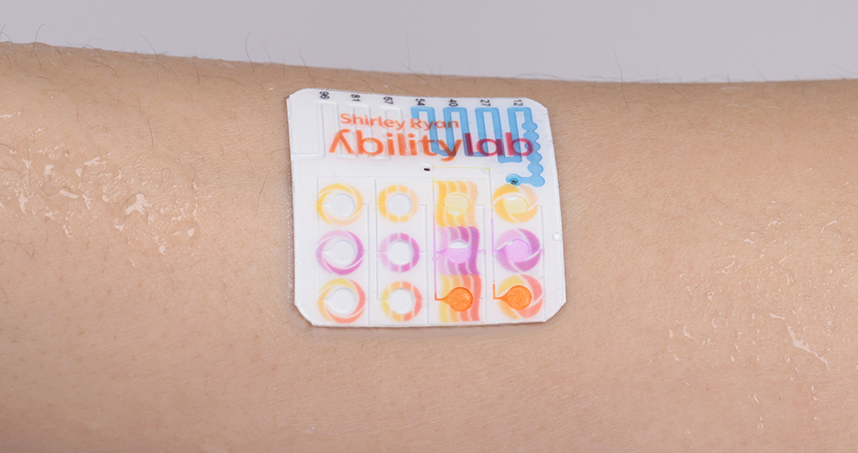Northwestern Engineering Teams with Sports and Rehabilitation Leaders to Advance Sweat Analysis Technologies
John Rogers’s microfluidic device heads out of the lab and into widespread distribution
Read more about the work in the Financial Times.
Athletes, military personnel, and fitness pros often reach for sports drinks to stay hydrated, replenish their electrolytes, and stay on top of their game. But the lack of solutions to quickly and accurately monitor sweat rate and electrolyte loss makes it challenging to analyze specific hydration needs.
Now, Northwestern Engineering is partnering with a broad collection of end users and experts in hydration analysis to bring a new state-of-the-art technology out of the lab and into widespread distribution. The product is a wearable microfluidic system that measures sweat and sweat biomarkers accurately and in real time.
Northwestern Engineering’s John A. Rogers is teaming with the Gatorade Sports Science Institute, the Seattle Mariners, the US Air Force, and the Shirley Ryan AbilityLab to further develop, test, and validate the device, which monitors sweat loss and analyzes sweat chemistry, with a simple, real-time visual readout.

Previously developed in Rogers’s laboratory, the soft, flexible device sits on the skin and measures emerging sweat to determine how the body responds to exercise. Launched from Rogers’s group through Northwestern’s Innovation and New Ventures Office (INVO), startup Epicore Biosystems has established large volume manufacturing capabilities for these microfluidic devices and has plans to co-package them with nutritional, skin health, cosmetics, and sports hydration products, with additional possibilities for use in clinical medicine and rehabilitation.
“The Gatorade Sports Sciences Institute knows a great deal about sweat, and they have very rigorous testing protocols for evaluating new technologies in this space,” said Rogers, the Louis Simpson and Kimberly Querrey Professor of Materials Science and Engineering, Biomedical Engineering, and Neurological Surgery in Northwestern’s McCormick School of Engineering and Feinberg School of Medicine, and director of the Center for Bio-Integrated Electronics (CBIE).
“Our mission at the Gatorade Sports Science Institute has always been to help athletes optimize their health and performance through research and education in hydration and sports science,” said Dr. Lindsay Baker, principal scientist at the Gatorade Sports Science Institute. “Through our partnership with Epicore Biosystems, we’re developing exciting new ways to measure and monitor sweat, which can help us better recommend hydration strategies for our athletes.”
Initially introduced in 2016, Rogers’s microfluidic design has come a long way in the past year. Earlier designs measured chloride loss, glucose, lactate, and pH levels in sweat. Newer platforms also quantify concentrations of heavy metals like lead and arsenic, and urea and creatinine levels, the latter of which relates to kidney health.
The latest devices can also measure these chemistries continuously, in real-time, allowing wearers to monitor how their sweat chemistry changes during an exercise regimen and throughout the day.
“The devices from a year ago could determine the average chloride concentration during an exercise period,” Rogers said. “But now we have devices that fill sequentially in time. This is important because variations in sweat biomarkers give a sense of fatigue level as you’re exercising. We didn’t have that capability previously.”
Even better: the athlete does not need to pause his or her workout in order to decipher complicated information. Instead, he or she can monitor these sequentially changing levels with a simple glance. During exercise, sweat winds its way through the device’s tiny microscopic channels and into different compartments. In those compartments, reactions with chemical reagents result in visible color changes that quantitatively relate to electrolyte concentrations.
“Most people want to know if they are losing a lot of chloride, a little bit, or almost none,” Rogers said. “They can just eyeball the device and determine if their electrolyte levels are high, medium, or low.”
Co-authored with scientists at the Gatorade Sports Science Institute, the research was published online today, February 16, in the journal Science Advances. Rogers will also present the work as a part of his talk on bio-integrated technologies on February 17 at the American Association for the Advancement of Science (AAAS) annual meeting in Austin, Texas.
Another unique feature of these latest platforms is their ability to measure users’ sweat during aquatic sports, even when fully underwater. New adhesive materials and microfluidic designs maintain water-tight seals to the skin to capture and analyze sweat, while preventing surrounding water from entering the device’s microscopic channels. The systems were first deployed on triathletes and are now routinely used by Northwestern’s swimming team.
“We've been concerned about the impact of sweating on hydration and performance during training and competition, but until now we've had no way to make quantitative measurements,” said Jarod Schroeder, head coach of Northwestern’s men’s swimming team. “Skin-mounted microfluidic devices from the Rogers group allow us, for the first time, to determine sweat and electrolyte loss continuously as it occurs while in the pool during swimming, without any adverse impact on our athletes. The insights are intriguing; the remarkably high levels of sweat loss that occur in the pool demand careful scheduling for rehydration.”
Through Epicore Biosystems and the CBIE, devices are now in widespread deployment with a broad range of different outside organizations. The Seattle Mariners Major League Baseball team is using hundreds of the devices to track players during spring training.
“These thin, flexible microfluidic networks allow us to quantitatively track sweat loss and sweat chemistry across players in our organization,” said Lorena Martin, a medical doctor and the Mariners’ director of high performance. “This data can provide us with unique, detailed, player-specific information on electrolyte balance and body chemistry at any point during a game or practice.”
Active duty airmen at the Wright-Patterson Air Force Base in Dayton, Ohio are also using the devices.
“Sweat is rich in biochemical information that is relevant to physiological health and cognitive state,” said Jennifer Martin, a research chemist at the Air Force Research Laboratory. “The ability to monitor sweat loss and sweat chemistry in situ on the skin is of interest because the data may allow us to more effectively manage military readiness under grueling conditions in training or on the battlefield.”
In a more unusual application, patients are using the devices at the Shirley Ryan AbilityLab, one of the nation’s top translational research hospitals. Researchers there are exploring left/right asymmetries in sweating as a metric for recovery in stroke patients. The devices also help clinicians monitor differences in patients’ sweat chemistry over the course of rehabilitation process.
“The highly visual and dynamic nature of these devices allow our clinicians to readily monitor sweat loss and physical exertion in patients undergoing rehabilitation from autonomic disorders like stroke,” said Arun Jayaraman, associate professor of physical medicine and rehabilitation and physical therapy and human movement sciences. “The unique capacity to measure sweating across multiple body locations simultaneously opens up the possibility for using anomalous sweating as an indicator of recovery status.”
With the technology on track for commercialization, Rogers’s team, including Dr. Roozbeh Ghaffari, the director of translational science at CBIE, is continuing to test the microfluidic devices in scaled studies with an expanding collection of partners. Rogers anticipates that a version of this technology could be in the hands of military personnel, sports teams, and consumers in the next year, due in large part to the simple, low-cost nature of the technology, and its broad appeal to end users.
“Joining forces with science-driven organizations, like the US Air Force and Gatorade, will help us to deliver on a new class of wearable technology — one that provides quantitative information on sweat,” Ghaffari said, “with the potential to fundamentally change the way that people manage their hydration, health, and performance.”
